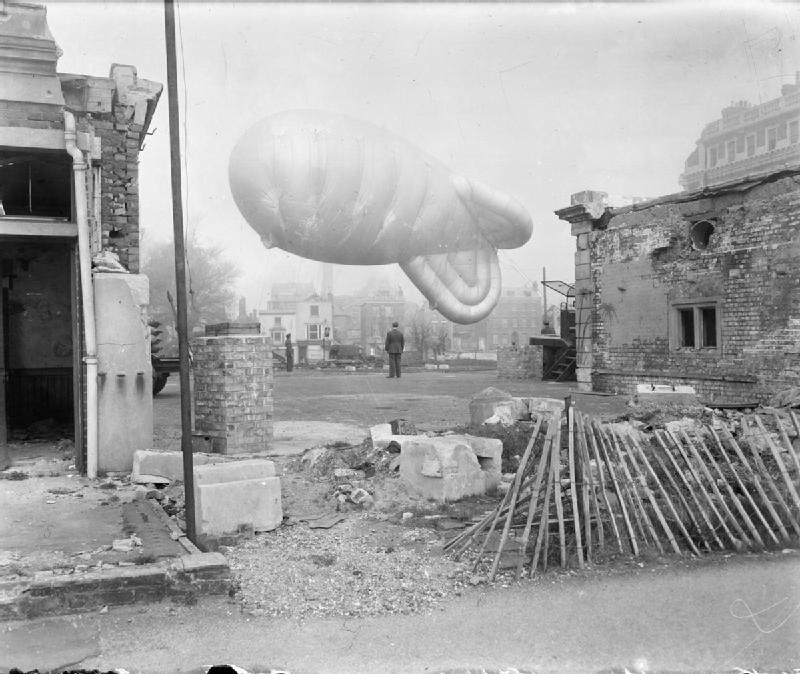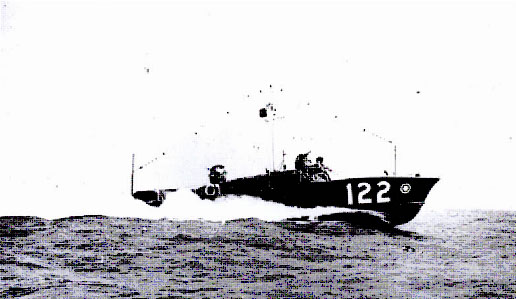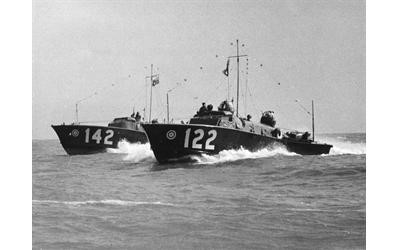 Click
for Site Directory
Click
for Site Directory
1465905 Leading Aircraftman Ralph John MOSS 961 Barrage Balloon Squadron
961 Squadron was based at Dover in Kent and apart from 16 land based balloons like the one shown below they had 8 waterborne ones and had to
use launches to service these at sea.

961 Squadron at Granville Gardens , Dover, Kent
He was part of a crew of 961 Squadron men who were all killed, injured and died of wounds on the 19th/20th August 1942.
This was the time of the Dieppe Raid and the crew were in Air Sea Rescue High Speed Launch 122 along with Air Sea Rescue High Speed Launch 123 to provide pickup for downed airmen and other
servicemen at sea. The RAF often used the balloon crews on the launches because they had a number of balloons set up on buoys and barges out at sea to prevent German aircraft dropping mines
at sea. The launches were used to service these balloons and as a result these crews became very good at using the launches for other things, including air sea rescue.


The Gloucester Echo ran a story on 24 August 1942:
“RESCUE-LAUNCH THRILLS AT DIEPPE
For 16 hours throughout the Dieppe operation air-sea launches played a vital part. They were out before dawn and were placed in three lines which stretched into mid-channel. Over them
patrolled the rescue aircraft (Lysanders, Defiants and Walrus). These planes did more than 4,000 miles during the day says the Air Ministry News Service. They flew beneath the Spitfire
“umbrella” and although some of the pilots had exciting experiences not one was shot down. Thirty pilots who had baled out or crash-landed on the sea were rescued.”
The event leading up to their deaths was a story that showed the true grit and courage of our airmen and the savage nature of the Nazi regime:
Whilst on duty as Master of Air Sea Rescue High Speed Launch 123 on the 19th August 1942, in company with Air Sea Rescue High Speed Launch 122, Pilot Officer Sydney Spencer Bates observed
that Air Sea Rescue High Speed Launch 122 was being attacked by some six enemy aircraft and had been set on fire. In spite of the great risk incurred, Pilot Officer Bates at once went to the
assistance of Air Sea Rescue High Speed Launch 122, and was himself attacked by enemy aircraft, but although under attack, proceeded calmly with the rescue of the survivors of Air Sea Rescue
High Speed Launch 122. Unfortunately, Air Sea Rescue High Speed Launch 123 was also set on fire and suffered casualties and had to be abandoned, the crew jumping into the sea. For his
bravery. Pilot Officer Bates was awarded the M.B.E. on 15th December 1942.
Below are the named crew of Air Sea Rescue High Speed Launch 122, five of whom died at sea and one survived (Moss) but died the following day.
In addition, six of the crew of Air Sea Rescue High Speed Launch 147 died as well and one from Air Sea Rescue High Speed Launch 123.
108368 F/O John Richard Loessel Hill H.S.L.122 Skipper 961 Balloon Squadron
(Son of Charles A. R. and Lucia M. Hill; husband of Margaret Blanche Hill, of Essendon, Victoria, Australia)
1104514 Sgt Frank Ostell Blaylock Osbourne H.S.L.122 M.B.C. 961 Balloon Squadron
(Son of Henry Hamilton Osborne and Margaret Osborne; husband of Dorothy Osborne, of Redbridge, Hampshire)
1375497 Cpl Rex Arthur Appleby H.S.L.122 M.B.C. 961 Balloon Squadron
(Son of Frank James Appleby and Helen Agnes Appleby; husband of Eileen Maude Appleby, of Morden, Surrey)
1383647 L.A.C. Donald Basil Dennis H.S.L.122 M.B.C. 961 Balloon Squadron
(Son of Basil and Edith Mary Dennis, of Rye, Sussex.)
1458804 L.A.C. Harold Kenneth Good H.S.L.122 M.B.C. 961 Balloon Squadron
(Son of Harold and Florence May Good, of Hull)
1464905 L.A.C. Ralph John Moss H.S.L.122 M.B.C. 961 Balloon Squadron
(Son of Francis James Moss and Lily Estelle Moss, of Leigh-on-Sea)
1459634 L.A.C. Frank Stephen Wilkins H.S.L.123 M.B.C. 961 Balloon Squadron
(Son of Matilda Wilkins, of Cricklewood, Middlesex; husband of Hilda Frances Wilkins, of Broadstairs, Kent)
110142 F/O Rodney Broad H.S.L.147 Skipper 961 Balloon Squadron
(Son of Nelson and Alice Broad; husband of Maud Kathleen Broad)
630346 Sgt James Stanley Stephens H.S.L.147 M.B.C. 961 Balloon Squadron
(Son of Charles and Lucy Eleanor Stephens, of Scarborough, Yorkshire; husband of Ethel May Stephens, of Scarborough)
1383840 L.A.C. Ernest Harold Bambridge H.S.L.147 M.B.C. 961 Balloon Squadron
(Son of Alfred and Edna Susannah Bambridge, of Tottenham, Middlesex)
1453926 L.A.C. Frederick Charles Curtiss H.S.L.147 M.B.C. 961 Balloon Squadron
(Son of Frederick and Alice Curtis; husband of Irena Suzanna Curtis, of West Kensington, London)
1051146 L.A.C. Arnold Webster Sutton H.S.L.147 N/ORD 961 Balloon Squadron*
(Son of Henry Higginson Sutton and Nellie Maud Sutton, of Wolverhampton)
*Buried at Pihen-les-Guines war cemetery at Calais
1516941 L.A.C. Richard Frederick Stephenson. H.S.L.147 M.B.C. 961.Balloon Squadron.
(Son of H. and Alice Stephenson; husband of Constance Mary Stephenson, of Oadby, Leicestershire)
L.A.C. Sutton was washed up near the French Coast it is not clear if he was alive at that time and buried in France, L.A.C. Moss was brought back to Britain but died on 20th August.
The bodies of Hill, Osbourne, Appleby and Dennis have never been found and they were classed as lost at sea and are commemorated on the Runnymede Memorial.
It is noted that some records indicate an L.A.C. Kraft (Air Sea Rescue High Speed Launch 123) as being on board 123 with Wilkins but he is not identifiable and not recorded as being killed in action
on 19th August 1942 as such I have decided not to include him until it can be proved he was on board and /or that he died on 123. Nothing shows up for a man named "Kraft" on the CWGC.
The Dieppe Raid showed that there was incredible bravery by all who took part. 1331108 L.A.C. Albert Dargue, R.A.F., was awarded the B.E.M. in the London Gazette on 29 December 1942: The
citation
states:
‘Leading Aircraftman Dargue was Nursing Orderly on a High Speed Launch during
the combined operations on 19 August 1942. In spite of wounds, he endeavoured to
carry out first-aid to the
wounded until he was picked up in a seriously wounded condition. The courage and valuable services rendered by Leading Aircraftman Dargue are typical of the high qualities displayed by the
nursing
orderlies, who have carried out hazardous operations in High Speed Launches
which play an essential part in Air Sea Rescue.’
Albert Drague was serving in H.S.L. 122 of No. 27 Air Sea Rescue at Dover at the
time of operation “Jubilee”.
Dargue was plucked from the water by Flight Lieutenant D. R. “Don” Morrison, D.F.C., D.F.M., No 401 (R.C.A.F.) Squadron, himself having been picked up by H.S.L. 177 after being downed earlier
that day.
Morrison noticed a semi-conscious seaman drifting away from the launch. He immediately dived into the sea and burning oil to reach the badly injured man, bringing him alongside the launch
where he was recovered on board. He was Leading Aircraftman Albert Dargue, the medical orderly of H.S.L. 122, which had been attacked and set on fire by German fighters. Despite being badly
injured, Dargue tended the seriously wounded until H.S.L. 123 pulled alongside. Only four men were left alive and Dargue dragged the other three survivors on deck, but just as they were about
to be transferred, H.S.L. 123 also came under attack and was severely damaged. As the launch caught fire, the master gave the order to abandon ship. Dargue inflated the Mae Wests of the three
injured men and pushed them overboard before he
jumped. Exhausted and weak from his wound, he could do little to help himself
until Morrison rescued him.
Once H.S.L. 177 had picked up the 14 survivors the master headed for Newhaven at
full speed, where the wounded were quickly evacuated to hospital. Morrison
returned to his squadron and was
soon back on duty. Following the Dieppe operation there were a number of gallantry awards for the men of the R.A.F’s high speed launches, including an M.B.E. to Conway and a B.E.M. to the
brave L.A.C. Albert Dargue.
Morrison wrote a detailed report of his experiences but made no mention of his
own courageous part. He was loud in his praise for the men who manned the R.A.F.
rescue launches and concluded
his report: ‘There can be no question as to the bravery of these men of the Air Sea Rescue Service who were often working within sight of the French coast. For myself, I would rather meet a FW
190 head-on in my Spitfire than meet one from a
rescue launch.’ ’
‘There were many lessons to be learnt from the Dieppe raid, in particular the
lack of armour plate protection for the gunners on rescue launches operating in
the combat area. There was also a
clear need for more capable armament, and the Admiralty agreed to supply 15 Oerlikon guns for the R.A.F’s launches at Dover and Newhaven. During October approval was given for 32 launches
based at the east and south coast units to be provided with one 20-mm. Oerlikon and four .303 Vickers guns on twin pedestal mountings. It was also agreed that armour plating should be provided
for the more vulnerable areas of the launches.’
Assuming Dargue had been a regular member of H.S.L. 122 since his arrival at No.
27 A.S.R. Dover, he would have been the veteran of numerous rescue operations in
the interim, the unit’s O.R.B.
revealing another encounter with enemy aircraft
on 16 April 1942, when 122 was attacked by a pair of 109s off Folkestone - ‘No
casualties but bullet hole damage to hull’ (the unit’s O.R.B. refers).
In 2009 his medals: British Empire Medal, (Military) G.VI.R., 1st issue (1331108
L.A.C. Albert Dargue, R.A.F.); 1939-45 Star; Atlantic Star; Defence and War
Medals 1939-45, were sold for £4100.
Another
brave airman was
755120
Acting Corporal M. Nunn, Royal Air Force, the last man left standing on his Air
Sea Rescue (A.S.R.) High Speed Launch (H.S.L.) after it was attacked by enemy
aircraft: rescued by another H.S.L., this too had to be abandoned as a result of 30 minutes at the mercy of half a dozen F.W. 190s, until, at length, a few survivors were plucked to safety by a third
launch from No. 27 A.S.R. Dover. Michael Nunn was born in South Hadley, Barnsley in August 1920 and enlisted in the Royal Air Force at Cambridge in June 1939. After initial training, he was
posted to No.
27 Air Sea Rescue (A.S.R.) at Dover in December 1941.
For his bravery off Dieppe in August 1942 he was awarded the B.E.M. in the
London Gazette on 29 December 1942. The original recommendation states:
‘On 19 August 1942, A.C.1 Nunn was Wireless Operator in R.A.F. High Speed Launch
(H.S.L.) 122. During operations the launch was severely attacked by enemy
aircraft. He stuck to his post until
the W./T. was shot away and, going on deck, found he was the only member of crew uninjured, the other members being either killed or wounded. He showed great presence of mind by first
endeavouring to stop engines until he was almost overcome by fumes. He then ran to the wheel and continued to steer the launch for the British coast until sometime later he was taken off by
H.S.L. 123. Shortly afterwards H.S.L’s 122 and 123 were sunk by the enemy. A.C. 1 Nunn has been with H.S.L’s Dover since December 1941 and has carried out numerous operations with skill and
efficiency.’
Of the 14 High Speed launches called out on 19 August 1942, in response to no
less than 47 “Mayday” calls, three were lost to enemy action, among them, as
related above, Nunn’s H.S.L. 122 -
five of her crew were killed, including Flying Officer J. R. Hill, four wounded and two taken P.O.W. Her fate - and that of H.S.L. 123 - is best summarised in an official report submitted by Squadron
Leader Coates,
from which the following extract has been taken:
‘At about 16.35, four miles S.E. of the position, going north, 123 was attacked
by two out of four F.W. 190s that appeared ahead. L.A.C. Wilkins was wounded and
Sergeant Smith slightly wounded.
A “Help” signal was sent. The planes did not return and course was maintained. Shortly afterwards the boat was challenged from the shore and the batteries opened fire, the shells falling astern.
At 16.50 four F.W. 190s attacked from the port beam and course was altered towards them and no casualties resulted. A second “Help” signal was sent. Course was altered to N.W. to try and
shake off the planes, which again disappeared, and to contact 122 [with Nunn aboard] for mutual aid and support ... 122, when sighted, was being bombed by a Heinkel and when closed at 17.15
was found to have been badly damaged by cannon and machine-gun fire, and with only five men left alive. These were being transferred when six or eight F.W. 190s appeared and attacked from
the port beam, four serious casualties being sustained. A signal “Urgent Help 182 Dungeness 23” was sent. The boats then became separated. In view of the fact that not a single British fighter
had provided cover or was even sighted from the time the English coast was left, and that we had been informed that none could be expected, it was considered that absolutely no possibility
remained of making the 25 miles to our coast against the concerted attacks in operation. The boat [122] was therefore abandoned at 17.20. Whilst the survivors were in the water both boats were
attacked for about half an hour and set completely on fire H.S.L. 177, five to six miles distant, apparently saw smoke and having contacted R.M.L. 513 and two Spitfires, proceeded and performed
a plucky and
skilful rescue at about 18.00, the F.W. 190s making off on their approach ... ’
Assuming Nunn had been a regular member of H.S.L. 122 since his arrival at No.
27 A.S.R. Dover, he would have been the veteran of numerous rescue operations in
the interim, the unit’s O.R.B.
revealing another encounter with enemy aircraft on 16 April 1942, when 122 was attacked by a pair of 109s off Folkestone - ‘No casualties but bullet hole damage to hull’ .
Having received his B.E.M. at a Buckingham Palace investiture held on 16 March 1943, and been advanced to Acting Corporal, Nunn transferred to No. 4 A.S.R. at Wick that September, where he
served until being released in October 1945;
His medals: British Empire Medal,
(Military) G.VI.R., 1st issue (755120 A.C. 1 M. Nunn, R.A.F.); 1939-45 Star;
Atlantic Star; Defence and War Medals, were sold in 2007 for £4500.